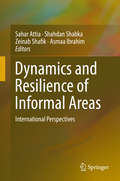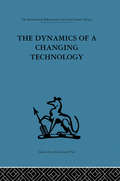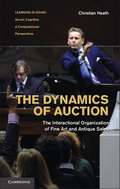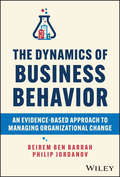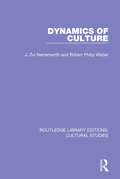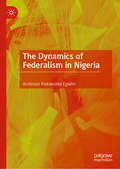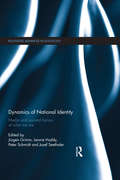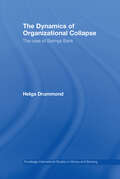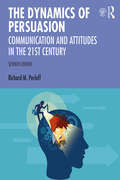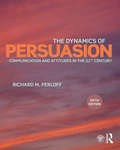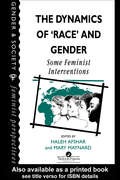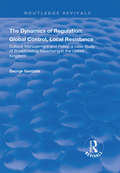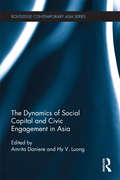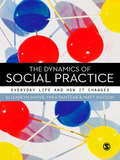- Table View
- List View
Dynamics and Resilience of Informal Areas
by Sahar Attia Shahdan Shabka Zeinab Shafik Asmaa IbrahimThis volume provides visionary approaches within the multi-disciplines engaged with informal settlements covering three main themes; 'Innovative Policies and Strategies to Informal Urbanism'; 'Production, Operation and the Life-World of Urban Space' and finally 'The Dynamics of Informal Settlements'. The book reflects multi-disciplinary experiences dealing with informality, where authors from a number of global regions present cases, practices and ideologies related to their respective context. This is elaborated through fifteen selected papers, most of which, were presented at the International conference: ARCHCAIRO 6 (the 6th International Conference), "RESPONSIVE URBANISM IN INFORMAL AREAS TOWARDS A REGIONAL AGENDA FOR HABITAT III". The conference was organized as a collaborative activity within the "Informal Urbanism Hub" of the HABITAT University Network Initiative (UNI), the Regional Office for Arab Countries, and Cairo University, aiming at reducing the gap between academia and practice.
The Dynamics and Social Outcomes of Education Systems
by Jan Germen Janmaat Marie Duru-Bellat Andy Green Philippe M�hautThis collection critically examines the dynamics and social outcomes of systems of lifelong learning.
The Dynamics of a Changing Technology: A case study in textile manufacturing
by Peter J Fensham Dougles HooperTavistock Press was established as a co-operative venture between the Tavistock Institute and Routledge & Kegan Paul (RKP) in the 1950s to produce a series of major contributions across the social sciences. This volume is part of a 2001 reissue of a selection of those important works which have since gone out of print, or are difficult to locate. Published by Routledge, 112 volumes in total are being brought together under the name The International Behavioural and Social Sciences Library: Classics from the Tavistock Press. Reproduced here in facsimile, this volume was originally published in 1964 and is available individually. The collection is also available in a number of themed mini-sets of between 5 and 13 volumes, or as a complete collection.
The Dynamics of Advertising
by Jackie Botterill Iain MacRury Barry RichardsThe authors suggest that advertisments, while important in our daily emotional self-management, are far more closely linked to the pragmatics of everyday life than their symbolic richness might suggest. Recent trends in advertisment content point to an important shift in our relationship to goods that reflects an increasing preoccupation with risk management.
The Dynamics of Auction
by Christian HeathEach year art and antiques worth many billions of pounds are sold at auction. These auctions consist of numerous, intense episodes of social interaction through which the price of goods rapidly escalates until sold on the strike of a hammer. In this book, Christian Heath examines the fine details of interaction that arises at auctions, the talk and visible conduct of the participants and their use of various tools and technologies. He explores how auctioneers, buyers and their representatives are able to transact the sale of diversely priced goods in just seconds. Heath addresses how order, trust and competition are established at auctions and demonstrates how an economic institution of some global importance is founded upon embodied action and interaction. The analysis is based on video recordings of sales of art and antiques gathered within a range of national and international auction houses in Europe and the United States.
The Dynamics of Business Behavior: An Evidence-Based Approach to Managing Organizational Change
by Beirem Ben Barrah Philip JordanovDiscover practical and relevant insights from behavioral science you can apply immediately to manage change in your organization In The Dynamics of Business Behavior: An Evidence-Based Approach to Managing Organizational Change, cognitive neuropsychologist Philip Jordanov and entrepreneur Beirem Ben Barrah deliver an eye-opening new treatment of how to create organizational change with an evidence-based approach. The book includes interviews with more than 40 industry professionals across 15 sectors from companies like Johnson & Johnson and the three biggest Dutch banks discussing change approaches, challenges, and interventions to help bridge the gap between theory and practice. Readers will find useful step-by-step guides on eighteen interventions for six change areas, including psychological safety for stakeholder engagement and re-anchoring for leadership support. This book also discusses: The importance of strategic planning and risk management in DEI efforts through surveys and focus groups, yearly health scans, and qualitative and quantitative data The most common myths that leaders accidentally buy into as they guide their organizations Case studies of contemporary companies overcoming challenges using brain and behavior science A startlingly insightful and, at times, counterintuitive guide to implementing behavioral science in real-world organizations, The Dynamics of Business Behavior: An Evidence-Based Approach to Managing Organizational Change will earn a place on the bookshelves of managers, executives, directors, entrepreneurs, founders, marketers, department heads, salespeople, and other business leaders.
Dynamics of Community Formation
by Robert W. Compton Jr. Ho Hon Leung Yaser RoblesThis interdisciplinary work discusses the construction, maintenance, evolution, and destruction of home and community spaces, which are central to the development of social cohesion. By examining how people throughout the world form different communities to establish a sense of home, the volume surveys the formation of identity within the context of rapid development, global and domestic neoliberal and political governmental policies, and various societal pressures. The themes of cooperation, conflict, inclusion, exclusion, and balance require negotiation between different actors (e. g. , the state, professional developers, social activists, and residents) as homes and communities develop.
The Dynamics of Conflict Between Bureaucrats and Legislators
by Gail JohnsonFirst Published in 1993. Routledge is an imprint of Taylor & Francis, an Informa company.
Dynamics of Culture (Routledge Library Editions: Cultural Studies)
by J. Zvi Namenwirth Robert Philip WeberThis book, first published in 1987, is a landmark contribution to macrosociology that extends the tradition of Sorokin, Durkheim, Marx, Weber and other founders of the discipline in new and exciting directions. Using their innovative content analysis methodology to examine American and British political documents, the authors show that the long-term dynamics of culture are subject to their own laws and are independent of the actions of 'great men' and other individual actors. This comprehensive volume brings together over two decades of the authors' research on culture indicators. Key findings include the identification of two long-term cultural cycles in the United States and Great Britain: one is related to party realignments, the other to long-term economic fluctuations. In addition, the authors demonstrate how culture provides the themes that political parties use to interpret economic conditions in their appeal for votes. Other results show that organizational cultures move in opposite directions from those in the culture of the larger society. The book also includes detailed discussions of both the methodology used to analyse text content and related metatheoretical issues in the study of cultural dynamics.
The Dynamics of Federalism in Nigeria
by Ambrose Ihekwoaba EgwimThis book analyzes the concept “true federalism” to examine whether there are definable dimensions of power-sharing that make ‘true federalism.’ The author takes a critical look at dimensions on political restructuring in Nigeria, which have been termed “true federalism.” The work fills a significant gap in the existing literature on the theory and practice of federalism. The project will be useful to the students and professors of African Studies, political science, Nigeria federalism, public administration and policy. Additionally, the monograph will be interesting to the general public who seek to know more about contemporary issues in Nigeria.
The Dynamics of Modern Society
by J. Goode WilliamSocial research efforts are often more concerned with basic social processes or patterns than with the dynamic relationship between social processes and social institutions. In this classic collection, contributors posit generalizations drawn from contemporary sociology. Their analyses go beyond elementary principles - they interpret them, qualify them, or state them more precisely. Each of the contributors focuses on the modern American social structure, and they are either explicitly comparative or have made observations that clearly are meant to apply to many countries.This volume both embodies and draws attention to newer developments in sociology. Like most steps forward in an advancing science, this orientation does not reject the older knowledge accumulated during earlier generations, but incorporates and expands upon it. The differences are in emphasis rather than any denial of the main body of accepted theory. On the other hand, the collection may be said to represent a response to the many criticisms, by humanists and sociologists alike, of the mainstream of contemporary sociology as it existed at the time of original publication in the late 1960s.Inquiries into social changes, like sociological studies of historical phenomena, may be viewed as modes of a comparative sociology: They permit us to test more fully sociological generalizations. The emphasis in this volume on historical and comparative studies and on social change parallels the growing attention of sociology to these problems. During the 1960s, social science turned from a nearly exclusive preoccupation with middle-class populations to a concern with social relations in other societies, past as well as present. In addition to enriching our knowledge, this broader view has increased both the precision and generalizing power of sociological principles.
Dynamics of National Identity: Media and Societal Factors of What We Are (Routledge Advances in Sociology)
by Leonie Huddy Peter Schmidt Jürgen Grimm Josef SeethalerGlobalization, immigration and economic crisis challenge the conceptions of nations, trans-national institutions and post-ethnic societies which are central topics in social sciences' discourses. This book examines in an interdisciplinary and international comparative way structures of national identity which are in conflict with or supporting multi-ethnic diversity and trans-national connectivity. The book’s first section seeks to clarify the concepts of national identity, nationalism, patriotism and cosmopolitism and to operationalize them consistently. The next section regards the diversity within national states and the consequences for the management of identity and intra-national integration. The third section focuses on external integration between different nations by searching for the "squaring of the circle" between the bonding with co-patriots and the critical reflection of one's own national perspective in relation to others. The last section explores to what extent and in which ways media use shapes collective identity.
The Dynamics of Organizational Collapse: The Case of Barings Bank (Routledge International Studies In Money And Banking Ser. #Vol. 46)
by Helga DrummondThe collapse of Barings Bank was a commercial catastrophe that resonated worldwide, showing what kind of secrets can lie behind an apparently successful organization. Following Nick Leeson‘s arrest and subsequent conviction for fraud, investment banks anxiously reviewed their risk management controls to make sure that it could never happen a
The Dynamics of Persuasion: Communication and Attitudes in the Twenty-First Century (Routledge Communication Series)
by Richard M. PerloffNow in its seventh edition, this essential text continues to provide students with a comprehensive yet accessible overview of the study and practice of persuasive communication. Attuned to the swift changes in the world of persuasion in the twenty-first century, this book covers how theories and research illuminate and adapt to our present digital era, with continued attention to ethical implications and today’s big topics. This new edition features updated definitions of key terms in the field as they relate to present-day practice; an integration of persuasion theories and the ubiquity of online influence; new examples and cases to illustrate persuasive communication’s approach to health campaigns, attitudes, communicator appeals, dissonance, and ethics; and a thorough reflection of the most current scholarship in the field. The Dynamics of Persuasion, Seventh Edition provides a solid foundation for undergraduate students in communication studies and psychology to grasp the key concepts and practices of persuasive communication today. The book is complimented by online resources for both instructors and students, including an instructor’s manual, lecture slides, sample test questions, and links to relevant articles and videos illustrating concepts presented in the text. Please visit www.routledge.com/cw/perloff.
The Dynamics of Persuasion: Communication and Attitudes in the Twenty-First Century (Routledge Communication Series)
by Richard M. PerloffThe Dynamics of Persuasion has been a staple resource for teaching persuasion for nearly two decades. Author Richard M. Perloff speaks to students in a style that is engaging and informational, explaining key theories and research as well as providing timely and relevant examples. The companion website includes materials for both students and instructors, expanding the pedagogical utilities and facilitating adoptions. The sixth edition includes: updated theoretical and applied research in a variety of areas, including framing, inoculation, and self-affirmation; new studies of health campaigns; expanded coverage of social media marketing; enhanced discussion of the Elaboration Likelihood Model in light of continued research and new applications to everyday persuasion. The fundamentals of the book – emphasis on theory, clear-cut explanation of findings, in-depth discussion of persuasion processes and effects, and easy-to-follow real-world applications – continue in the sixth edition.
The Dynamics of Persuasion: Communication and Attitudes in the 21st Century (Routledge Communication Series)
by Richard M. PerloffThe eighth edition of The Dynamics of Persuasion again guides readers in understanding the power and limits of persuasion in contemporary society. This edition continues its accessible and detailed illustration of the theoretical underpinnings of persuasive communication through contemporary and relevant examples of persuasion in action. It features coverage of new scholarship on misinformation, health communication, and persuasion effects, including careful attention to persuasion’s role in the Covid-19 pandemic. Important issues such as racial injustice, climate change, and barriers to persuading the politically and psychologically polarized also receive a fresh examination. The book brings together classic terms and approaches from earlier editions with new global developments to help readers adopt a more thoughtful perspective on persuasion. The eighth edition is an essential resource for courses in persuasion at the undergraduate and graduate levels within communication studies, psychology, and business programs. Online resources also accompany the text: an Instructor Manual that contains sample syllabi, key terms, chapter outlines, sample discussion questions, and links to relevant news articles and other online resources such as videos; Lecture Slides; and a Testbank. Please visit: www.routledge.com/9781032268187.
The Dynamics of Pilgrimage: Christianity, Holy Places, and Sensory Experience (Routledge Studies in Pilgrimage, Religious Travel and Tourism)
by Dee DyasThis book offers a systematic, chronological analysis of the role played by the human senses in experiencing pilgrimage and sacred places, past and present. It thus addresses two major gaps in the existing literature, by providing a broad historical narrative against which patterns of continuity and change can be more meaningfully discussed, and focusing on the central, but curiously neglected, area of the core dynamics of pilgrim experience. Bringing together the still-developing fields of Pilgrimage Studies and Sensory Studies in a historically framed conversation, this interdisciplinary study traces the dynamics of pilgrimage and engagement with holy places from the beginnings of the Judaeo-Christian tradition to the resurgence of interest evident in twenty-first century England. Perspectives from a wide range of disciplines, from history to neuroscience, are used to examine themes including sacred sites in the Bible and Early Church; pilgrimage and holy places in early and later medieval England; the impact of the English Reformation; revival of pilgrimage and sacred places during the nineteenth and twentieth Centuries; and the emergence of modern place-centred, popular 'spirituality'. Addressing the resurgence of pilgrimage and its persistent link to the attachment of meaning to place, this book will be a key reference for scholars of Pilgrimage Studies, History of Religion, Religious Studies, Sensory Studies, Medieval Studies, and Early Modern Studies.
Dynamics of Political Development in Afghanistan
by Hafizullah EmadiThe bureaucratic ruling elites in the state apparatus, lacking public support, relied on imperial powers for economic, military, and political assistance, and an assortment of established and rising imperial powers since the eighteenth century exploited the situation to advance their own agendas. This bookundertakes an analysis of the dynamics of political development in Afghanistan and policies of imperial powers that influenced the direction of development in the country, as well as the contributing issues of tribalism, ethnicity, and regionalism that constituted the very fabric of Afghanistan's society. "
Dynamics of Poverty in Rural Bangladesh
by Noriatsu Matsui Yukio Ikemoto Pk. Md. RahmanThe study of poverty dynamics is important for effective poverty alleviation policies because the changes in income poverty are also accompanied by changes in socioeconomic factors such as literacy, gender parity in school, health care, infant mortality, and asset holdings. In order to examine the dynamics of poverty, information from 1,212 households in 32 rural villages in Bangladesh was collected in December 2004 and December 2009. This book reports the analytical results from quantitative and qualitative surveys from the same households at two points of time, which yielded the panel data for understanding the changes in situations of poverty. Efforts have been made to include the most recent research from diverse disciplines including economics, statistics, anthropology, education, health care, and vulnerability study. Specifically, findings from logistic regression analysis, polychoric principal component analysis, kernel density function, income mobility with the help of the Markov chain model, and child nutrition status from anthropometric measures have been presented. Asset holdings and liabilities of the chronically poor as well as those of three other economic groups (the descending non-poor, the ascending poor, and the non-poor) are analyzed statistically. The degrees of vulnerability to poverty are examined by years of schooling, landholding size, gender of household head, social capital, and occupation. The multiple logistic regression model was used to identify important risk factors for a household's vulnerability. In 2009, some of the basic characteristics of the chronically poor were: higher percentage and number of female-headed households, higher dependency ratio, lower levels of education, fewer years of schooling, and limited employment. There was a low degree of mobility of households from one poverty status to another in the period 2004-2009, implying that the process of economic development and high economic growth in the macroeconomy during this time failed to improve the poverty situation in rural Bangladesh.
The Dynamics Of Race And Gender: Some Feminist Interventions (Gender And Society Ser.)
by Haleh Afshar Mary MaynardDuring the past decade, feminism and women's studies have been forced to acknowledge the diversities of women's experiences, as well as the patriarchal oppression that they share. The emphasis on difference has shattered the illusion of homogeneity and sisterhood which previously characterized white, middle-class Westernized feminist politics and analysis.; There is relatively little work which concentrates on the inter-relationships of race and gender in general, and the consequences of racism, for women of different backgrounds, in particular. "The Dynamics of Race and Gender" aims to contribute to the debate and understanding in this area. Emphasis has been given to age, class, disability, race and sexuality. The contributors to this volume are from different religious, cultural and ethnic backgrounds, giving a balanced and broad ranging perspective on this important social question.; Organized around three main themes, which are; issues of theory and method, questions of identity, racism and sexism at work, the chapters of this book indicate how the processes of race and gender interrelate in highly complex and contradictory ways. Demonstrating the benefits to be gained from analysing the interplay of various axes of differentiation in specific empirical and historical locations, and in doing so, under- scoring the point that diversity among women cannot be seen as a static phenomenon.
Dynamics of Rational Negotiation: Game Theory, Language Games and Forms of Life
by Jesús Padilla Gálvez Margit GaffalThis book uses game theory to analyze the strategies developed in negotiation processes. Offering a detailed analysis of competition and cooperation, it explores various bargaining strategies that result from the application of Nash equilibrium and mixed strategies. Employing a blend of game theory and real-world examples, the authors describe typical negotiation scenarios and unveil the art of negotiation strategy – dissecting both competitive and cooperative tactics.This comprehensive analysis explores the multifaceted dimensions of negotiation, highlighting not only formal aspects but also the economic, social, political, and human factors at play. The authors discuss the basic structures of cooperative and non-cooperative games and conduct a comprehensive analysis of the language games that take place in negotiations. They examine how negotiators belonging to different forms of life can trade with each other when their respective language games are different and prone to misinterpretation. The book also probes arbitration and mediation as conflict-resolution tools within this intricate landscape. Designed for the curious minds seeking insight into negotiation strategies, as well as students and scholars of diverse fields, this book fosters an understanding of negotiation's labyrinthine pathways. "Dynamics of Rational Negotiation" unlocks the door to negotiation's complexities, inviting readers to unravel the layers of human interaction.
The Dynamics of Regulation: Cultural Management and Policy: a case study of broadcasting advertising in the United Kingdom
by George GantziasThis title was first published in 2001. New technologies and the liberalization of the broadcasting and telecommunications market, together with the digitalization and globalization of new services, have challenged irrevocably not only the traditional markets and instructional structures but also the legal systems of broadcasting and telecommunication sectors in the 21st century. This text takes into account changes in digital broadcasting and telecommunication by pointing out that convergence is the process through which broadcasting, telecommunication, press and information sectors are transformed into new sectors (info-com arteries, info-com products, info-com services and info-com content) in order to be fully compatible with the emerging new info-communication industry in the digital transformation and info-communication era.
The Dynamics of Social Capital and Civic Engagement in Asia: Vibrant Societies (Routledge Contemporary Asia Series)
by Amrita Daniere Hy V. LuongThe purpose of this volume is to highlight the impacts on civic engagement of social capital, and its various component parts (trust, norms, networks and associations), in diverse parts of Asia. Addressing the pressing need for improved governance within the spatial, political and cultural realities in the rapidly transforming landscapes of Asia, the contributors to the book bring together interdisciplinary work that focuses on the ways in which civic engagement can link with social capital building. The goal of this volume is to inspire policy that recognizes that a vibrant society with access to rich stores of positive social capital requires civil society, alternate civilities and the state. The result is a dialogue on the interplay of social capital and civic engagement in socio-political contexts quite different from those found in the West. This book contributes to current discussions about the nature of social relations and their connection to politics and change and offers a unique lens into the validity of these important concepts in contemporary research across a variety of Asian settings. It will be of interest to social scientists across the board, especially those with an interest in Asia and Asian development.
The Dynamics of Social Practice: Everyday Life and how it Changes (Electronic Resource Ser.)
by Prof. Mika Pantzar Dr Matt Watson Dr Elizabeth ShoveEveryday life is defined and characterised by the rise, transformation and fall of social practices. Using terminology that is both accessible and sophisticated, this essential book guides the reader through a multi-level analysis of this dynamic. In working through core propositions about social practices and how they change the book is clear and accessible; real world examples, including the history of car driving, the emergence of frozen food, and the fate of hula hooping, bring abstract concepts to life and firmly ground them in empirical case-studies and new research. Demonstrating the relevance of social theory for public policy problems, the authors show that the everyday is the basis of social transformation addressing questions such as: * how do practices emerge, exist and die? * what are the elements from which practices are made? * how do practices recruit practitioners? * how are elements, practices and the links between them generated, renewed and reproduced? Precise, relevant and persuasive this book will inspire students and researchers from across the social sciences. Elizabeth Shove is Professor of Sociology at Lancaster University Mika Pantzar is Research Professor at the National Consumer Research Centre, Helsinki Matt Watson is Lecturer in Social and Cultural Geography at University of Sheffield.
The Dynamics of Social Welfare Policy (Fourth Edition)
by Joel Blau Mimi AbramovitzThe Dynamics of Social Welfare Policy uses the lens of an innovative policy model and an emphasis on social change to break new ground in social welfare policy texts. Starting from the explicit premise that every kind of social work practice embodies a social policy, the book stresses that policy knowledge enables social workers to help clients as well as to help themselves. Drawing on this awareness, the text then makes the standard social welfare policy material come alive by asking two new questions: 1) what factors trigger social change in these social policies?; and 2) how do these factors affect the social policies that influence what social workers actually do? To answer these questions, it develops a five-part policy model, which shows, through full chapters on each subject, how economics, politics, ideology, social movements, and the history of social welfare define social welfare policy.
